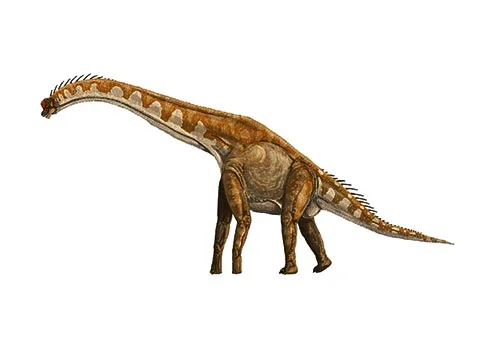Giraffatitan (Giraffe titan)

Jee-raf-ah-tie-tan
Werner Janensch – 1914
Herbivore
Estimated 21-23 meters long
Sauropod
G. brancai (type)
Africa, Tanzania - Tendaguru Formation
Late Jurassic, 155-150 million years ago
Giraffatitan Facts
Giraffatitan, meaning “giraffe titan,” is a genus of large sauropod dinosaur that lived during the Late Jurassic period, around 155 to 150 million years ago. Its fossils were first discovered in Tanzania and described by German paleontologist Werner Janensch in 1914.
Giraffatitan was one of the largest land animals that ever lived, with estimates of its length ranging from 21 to 23 meters (69 to 75 feet) and its weight from 20 to 40 metric tons (22 to 44 short tons). It had a long neck and tail, a massive body, and four stout legs with broad, rounded feet.
One of the most distinctive features of Giraffatitan is its long neck, which contained up to 19 vertebrae and measured up to 11 meters (36 feet) in length. The neck was likely used to reach up into the high branches of trees to browse on leaves and vegetation. Despite its massive size, Giraffatitan was a herbivore and likely had a high metabolic rate to sustain its large body.
Based on the structure of its bones and footprints, paleontologists believe that Giraffatitan moved on all four legs, rather than rearing up on its hind legs as some earlier depictions of sauropods suggested. Its feet were adapted for bearing its immense weight, with broad, flat soles and large, clawless toes.
Giraffatitan is an important dinosaur for paleontologists because it provides valuable insights into the evolution and biology of sauropod dinosaurs, which were among the largest and most successful animals of the Mesozoic era. Its massive size and unique adaptations for feeding and locomotion highlight the diversity and complexity of these impressive animals, and its importance in the ecological context of its time underscores the critical role that large herbivores played in shaping ancient ecosystems.
In conclusion, Giraffatitan is a fascinating dinosaur that helps us to better understand the diversity and adaptations of sauropod dinosaurs during the Late Jurassic period. Its massive size, long neck, and unique adaptations for feeding and locomotion set it apart from other dinosaurs, and its importance in the ecological context of its time underscores the complex and varied interactions between dinosaurs and their environments. As more fossils are discovered and studied, we are likely to learn even more about this impressive dinosaur and its place in the evolutionary history of sauropod dinosaurs.



